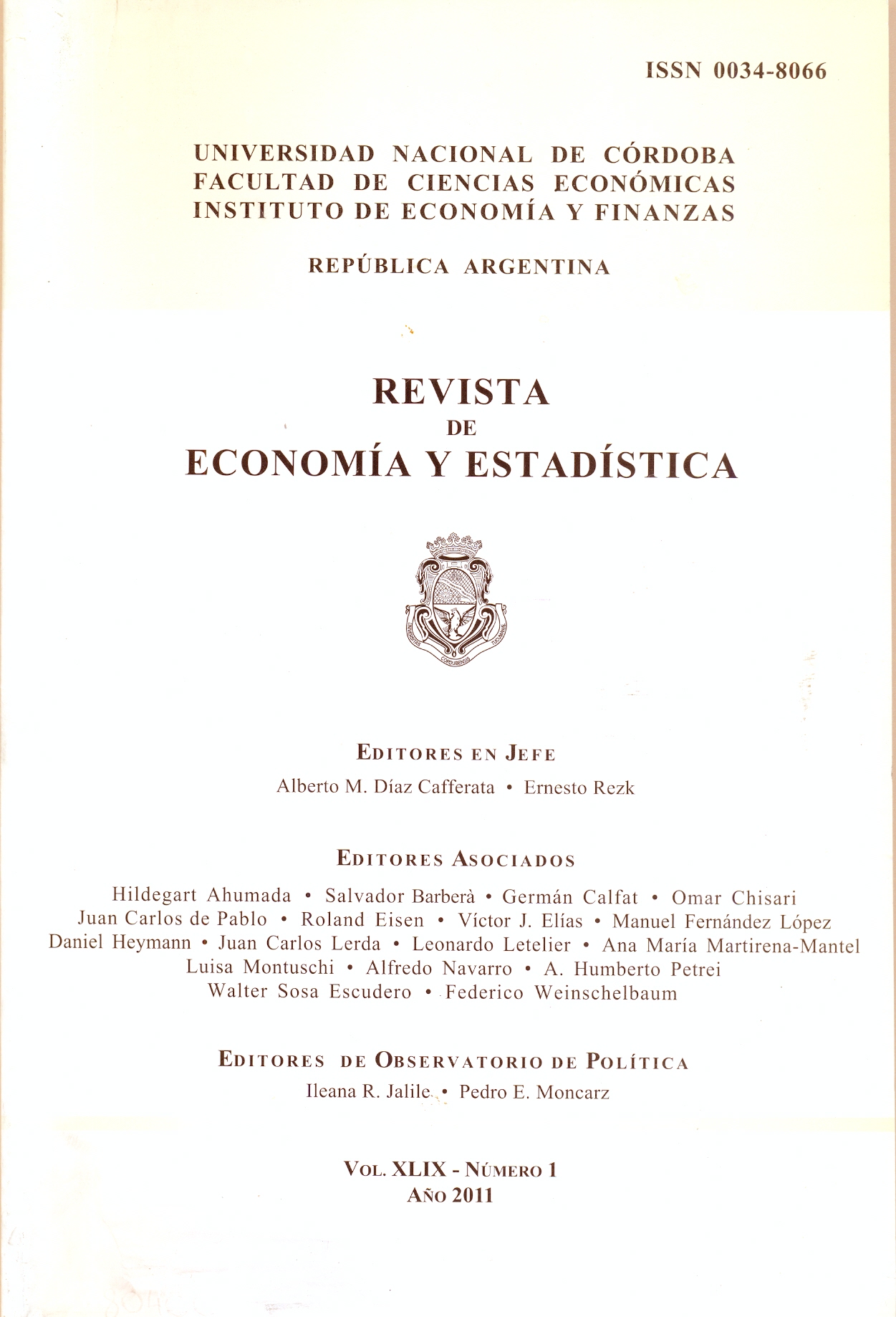Far from Champions, close to Midgets International Production Sharing in Central and South America
DOI:
https://doi.org/10.55444/2451.7321.2011.v49.n1.6511Keywords:
sharing production, fragmentation, trade in parts and components, outsourcingAbstract
This paper assesses the relative participation of Argentina, Brazil, Guatemala and Nicaragua in fragmented world production. Based on trade statistics from 2000 to 2004, it analyses whether the trade flows of these economies have evolved towards production sharing schemes and how great this type of trade is in order to sustain their presence into the world economy. Guatemala and Nicaragua hold a moderate participation in a global production chain under a North-South trade pattern. Nonetheless, their participation is threatened by international competition and their dependence on a unique market. Brazil has consolidated participation into few chains of production showing a more diversified North–South trade pattern. Argentina has attained insertion into the automotive chain of production whereas its participation in other ones is still limited. The country has a more South-South trade pattern, which exposes it to a certain degree of dependence.
Downloads
References
Ando, Mitsuyo, (2006). "Fragmentation and vertical intra-industry trade in East Asia," The North American Journal of Economics and Finance, Elsevier, vol. 17(3), pages 257-281, December.
Arndt, Sven, (1998), “Super-Specialization and the Gains from Trade”, Contemporary Economic Policy, v.16 October 1998, pages 480-485.
Athukorala, Prema-chandra & Yamashita, Nobuaki, (2006). "Production fragmentation and trade integration: East Asia in a global context," The North American Journal of Economics and Finance, Elsevier, vol. 17(3), pages 233-256, December.
Robert C. Feenstra, (1998). "Integration of Trade and Disintegration of Production in the Global Economy," Journal of Economic Perspectives, American Economic Association, vol. 12(4), pages 31-50, Fall.
Feenstra, R. C., Hanson, G., & Swenson D. L. (1998). “Offshore Assembly from The US: Production Characteristics of the 9802 Program”. National Bureau of Economic Research.-BER, Working Paper(98-10).
Fontagne, L., Freudenberg, M., & Unal-Kesenci, D. (1999). “Trade in technology and quality ladders: where do EU countries stand?”. International Journal of Development Planning Literature, 14(4), 561-582.
Fontagné, L. & Freudenberg Michael. (1997). “Intra-Industry Trade Methodological Issues Reconsidered”. CEPII, Working paper (97-01).
Grossman, G. M., & Helpman Elhanan. (2002). “Outsourcing in a Global Economy”. National Bureau of Economic Research - NBER, Working paper (8728).
Görg, H. (2000). “Fragmentation and trade: US inward processing trade in the EU”. Review of World Economics/ Weltwirtschaftliches Archives, 136(3), 403-422.
Hummels, D., Ishii, J., & Yi, K.-M. (2001). “The nature and growth of vertical specialization in world trade”. Journal of International Economics, 54(1), 75-96.
Hummels, D., Raporport, D., & Yi.Kei-Mu. (1997). “Globalisation and the Changing Nature of World Trade” . Economic Policy Review, 3(2), 53-81.
Jones, R., Kierzkowski, H., & Lurong, C. (2005). “What does evidence tell us about fragmentation and outsourcing?: Outsourcing and Fragmentation:Blessing or threat”. International Review of Economics & Finance, 14(3), 305-316.
Jones, R. W., & Kierzkowski, H. (2005). “International fragmentation and the new economic geography”. North American Journal of Economics & Finance, 16(1), 1-10.
Kimura, F., & Ando, M. (2005). “Two-dimensional fragmentation in East Asia: Conceptual framework and empirics: Outsourcing and Fragmentation: Blessing or threat”. International Review of Economics & Finance, 14(3), 317-348.
Lafay G. (1994). “The measurement of revealed comparative advantages”. In M. G. Dagenais & P. A.Muet (Eds.), International Trade Modeling.
Lemoine, F., & Unal-Kesenci, D. (2004). “Assembly Trade and Technology Transfer: The Case of China”. World Development, 32(5), 829-850.
Sanyal, K. K., & Jones, R. W. (1982). “The Theory of Trade in Middle Products”. American Economic Review, 72(1), 16.
Van Long, N., Riezman, R., & Soubeyran, A. (2005). “Fragmentation and services: Fragmentation and Services in the Modern Economy”. The North American Journal of Economics and Finance, 16(1), 137-152.
Yeats, A. (2001). “Just How Big is Global Production Sharing?” In: Fragmentation: New Production Patterns in the World Economy, Edited by .Sven W Arndt and H Kierskowski. Oxford University Press.
Downloads
Published
How to Cite
Issue
Section
License
Copyright (c) 2011 German Calfat, Danny Cassimon, Renato G. Flôres Jr., Ana Rivas

This work is licensed under a Creative Commons Attribution-NonCommercial-NoDerivatives 4.0 International License.
Authors who have publications with this journal agree to the following terms:
Authors retain their copyright and grant the journal the right of first publication of their work, which is simultaneously subject to the Creative Commons Attribution-NonCommercial-NoDerivatives 4.0 International License that allows third parties to share the work provided that its author and first publication in this journal are indicated.
Authors may adopt other non-exclusive licensing arrangements for distribution of the published version of the work (e.g. depositing it in an institutional telematic archive or publishing it in a monographic volume) as long as the initial publication in this journal is indicated.
Authors are allowed and encouraged to disseminate their work via the Internet (e.g. in institutional telematic archives or on their website) before and during the submission process, which can lead to interesting exchanges and increase citations of the published work. (See The Open Access Effect)









